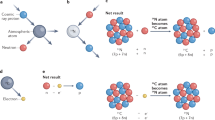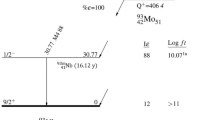Abstract
The cosmogenic isotope 41Ca with a half-life of 99,000 years can, in principle, serve as a tracer for environmental processes at an age scale beyond the reach of 14C. With accelerator mass spectrometry, the ratio of 41Ca/Ca has been measured down to the 10−15 level in natural samples. A wide range of potential applications, such as the burial dating of bones and exposure dating of rocks, require measuring even smaller 41Ca/Ca ratios in the range of 10−16 to 10−15. Here we achieved this by employing the atom-trap trace analysis method in which individual 41Ca atoms are selectively captured in a magneto-optical trap and counted by detecting their fluorescence. We realized a precision of 12% on the 41Ca/Ca ratio at the level of 10−16 and achieved a detection limit at the level of 10−17, which is below the distribution of natural abundances. We verified the accuracy of the 41Ca/Ca results through a series of measurements of reference samples, and performed demonstration analyses on bone, rock and seawater samples. Our table-top method has the potential to explore the suitability of 41Ca as a tracer.
This is a preview of subscription content, access via your institution
Access options
Access Nature and 54 other Nature Portfolio journals
Get Nature+, our best-value online-access subscription
$29.99 / 30 days
cancel any time
Subscribe to this journal
Receive 12 print issues and online access
$209.00 per year
only $17.42 per issue
Buy this article
- Purchase on Springer Link
- Instant access to full article PDF
Prices may be subject to local taxes which are calculated during checkout



Similar content being viewed by others
Data availability
Source data are provided in Extended Data Tables 2 and 3 and available via Zenodo at https://doi.org/10.5281/zenodo.7489164 (ref. 35).
References
Raisbeck, G. M. & Yiou, F. Possible use of 41Ca for radioactive dating. Nature 277, 42–44 (1979).
Gusonne, N. et al. Calcium Stable Isotope Geochemistry (Springer, 2016).
Jorg, G., Amelin, Y., Kossert, K. & von Gostomski, C. L. Precise and direct determination of the half-life of 41Ca. Geochim. Cosmochim. Acta 88, 51–65 (2012).
Taylor, R. E. Dating techniques in archaeology and paleoanthropology. Anal. Chem. 59, A317–A331 (1987).
Schaefer, J. M. et al. Cosmogenic nuclide techniques. Nat. Rev. Methods Primers 2, 18 (2022).
Fink, D., Klein, J., Middleton, R., Vogt, S. & Herzog, G. F. 41Ca in iron falls, grant and estherville: production-rates and related exposure age calculations. Earth Planet. Sci. Lett. 107, 115–128 (1991).
Welten, K. C. et al. Terrestrial ages, pairing, and concentration mechanism of Antarctic chondrites from Frontier Mountain, Northern Victoria Land. Meteorit. Planet. Sci. 41, 1081–1094 (2006).
Welten, K. C., Caffee, M. W., Hillegonds, D. J., Masarik, J. & Nishiizumi, K. Identifying large chondrites using cosmogenic radionuclides. Nucl. Instrum. Methods Phys. Res. B 268, 1185–1188 (2010).
Johnson, R. R. et al. Calcium resorption from bone in a human studied by 41Ca tracing. Nucl. Instrum. Methods Phys. Res. B 92, 483–488 (1994).
Sharma, M., Bajzer, Z. & Hui, S. K. Development of 41Ca-based pharmacokinetic model for the study of bone remodelling in humans. Clin. Pharmacokinet. 50, 191–199 (2011).
Jackson, G. S. et al. Biomedical graphite and CaF2 preparation and measurement at PRIME Lab. Nucl. Instrum. Methods Phys. Res. B 361, 358–362 (2015).
Henning, W. et al. Calcium-41 concentration in terrestrial materials: prospects for dating of Pleistocene samples. Science 236, 725–727 (1987).
Fink, D., Middleton, R., Klein, J. & Sharma, P. 41Ca: measurement by accelerator mass spectrometry and applications. Nucl. Instrum. Methods Phys. Res. B 47, 79–96 (1990).
Fink, D., Klein, J. & Middleton, R. 41Ca: past, present and future. Nucl. Instrum. Methods Phys. Res. B 52, 572–582 (1990).
Steinhof, A. et al. A 82Kr pilot beam for the accelerator mass-spectrometry of 41Ca. Nucl. Instrum. Methods Phys. Res. B 52, 391–397 (1990).
Merchel, S. et al. A multi-radionuclide approach for in situ produced terrestrial cosmogenic nuclides: 10Be, 26Al, 36Cl and 41Ca from carbonate rocks. Nucl. Instrum. Methods Phys. Res. B 268, 1179–1184 (2010).
Wallner, A. et al. Fluorides or hydrides? 41Ca performance at VERA’s 3-MV AMS facility. Nucl. Instrum. Methods Phys. Res. B 268, 799–803 (2010).
Rugel, G. et al. The first four years of the AMS-facility DREAMS: status and developments for more accurate radionuclide data. Nucl. Instrum. Methods Phys. Res. B 370, 94–100 (2016).
Sasa, K. et al. The 6 MV multi-nuclide AMS system at the University of Tsukuba, Japan: first performance report. Nucl. Instrum. Methods Phys. Res. B 437, 98–102 (2018).
Wallner, A. et al. Accelerator mass spectrometry with ANU’s 14 million volt accelerator. Nucl. Instrum. Methods Phys. Res. B 534, 48–53 (2023).
Wendt, K. & Trautmann, N. Recent developments in isotope ratio measurements by resonance ionization mass spectrometry. Int. J. Mass Spectrom. 242, 161–168 (2005).
Chen, C. Y. et al. Ultrasensitive isotope trace analyses with a magneto-optical trap. Science 286, 1139–1141 (1999).
Lu, Z. T. et al. Tracer applications of noble gas radionuclides in the geosciences. Earth-Sci. Rev. 138, 196–214 (2014).
Moore, I. D. et al. Counting individual 41Ca atoms with a magneto-optical trap. Phys. Rev. Lett. 92, 153002 (2004).
Hoekstra, S., Mollema, A. K., Morgenstern, R., Wilschut, H. W. & Hoekstra, R. Single-atom detection of calcium isotopes by atom-trap trace analysis. Phys. Rev. A 71, 023409 (2005).
Raab, E. L., Prentiss, M., Cable, A., Chu, S. & Pritchard, D. E. Trapping of neutral sodium atoms with radiation pressure. Phys. Rev. Lett. 59, 2631–2634 (1987).
Mills, M. et al. Efficient repumping of a Ca magneto-optical trap. Phys. Rev. A 96, 033402 (2017).
Fu, Y. C., Zhou, W. J., Cheng, P. & Zhang, L. Y. A new capability for 41Ca analysis using CaF3– at the Xi’an-AMS. Nucl. Instrum. Methods Phys. Res. B 438, 162–165 (2019).
Rugamas, F. et al. Angular profiles of molecular beams from effusive tube sources: I. Experiment. Meas. Sci. Technol. 11, 1750–1765 (2000).
Dunai, T. J. Cosmogenic Nuclides: Principles, Concepts and Applications in the Earth Surface Sciences (Cambridge Univ. Press, 2010).
Gosse, J. C. & Phillips, F. M. Terrestrial in situ cosmogenic nuclides: theory and application. Quat. Sci. Rev. 20, 1475–1560 (2001).
Borchers, B. et al. Geological calibration of spallation production rates in the CRONUS-Earth project. Quat. Geochronol. 31, 188–198 (2016).
Schaefer, J. M. et al. Greenland was nearly ice-free for extended periods during the Pleistocene. Nature 540, 252–255 (2016).
Marrero, S. M., Phillips, F. M., Caffee, M. W. & Gosse, J. C. CRONUS-Earth cosmogenic 36Cl calibration. Quat. Geochronol. 31, 199–219 (2016).
Xia, T.-Y. et al. Source data associated with the article ‘atom-trap trace analysis of 41Ca/Ca down to the 10−17 level’. Zenodo https://doi.org/10.5281/zenodo.7489164 (2023).
Acknowledgements
We thank D. Sheng, A.-W. Liu, Q.-X. Li and G. Jin for helpful discussions. We thank T.-F. Xu and Y. Yang for providing the seawater sample. This work is supported by the Innovation Program for Quantum Science and Technology through grant no. 2021ZD0303100 to T.-Y.X., W.-W.S., W.J., G.-M.Y., H.-M.Z., T.X. and Z.-T.L.; the National Natural Science Foundation of China through grant no. 41727901 to T.-Y.X., W.-W.S., S.E., W.J., G.-M.Y., H.-M.Z., T.X. and Z.-T.L.; the Strategic Priority Research Program of the Chinese Academy of Sciences through grant no. XDB21010200 to T.X. and Z.-T.L.; and Innovation Program for Quantum Science and Technology through grant no. 2021ZD0303101 to T.-Y.X., W.-W.S., S.E., W.J., G.-M.Y., H.-M.Z., T.X. and Z.-T.L.
Author information
Authors and Affiliations
Contributions
T.X. and Z.-T.L. conceived the research and supervised the project. T.-Y.X., W.-W.S., S.E., W.J., G.-M.Y., H.-M.Z., T.X. and Z.-T.L. developed the ATTA apparatus, W.-W.S. performed the ATTA measurements, T.-Y.X. developed the procedure for calcium extraction and preparation, G.-D.M. and T.-Y.X. developed the procedure for extracting calcium from granite, Y.-C.F. performed the AMS measurements, and G.-D.M. and F.H. collected the granite sample. W.-W.S., T.-Y.X., W.J., T.X. and Z.-T.L. analysed the data and discussed the results. T.-Y.X., W.-W.S., T.X. and Z.-T.L. wrote the paper. All the authors reviewed the paper.
Corresponding authors
Ethics declarations
Competing interests
T.-Y.X., T.X., W.-W.S., Z.-T.L. and W.J. have applied for a patent on the basis of this work (Chinese patent application no. CN115201172A, in substantive examination). The other authors declare no competing interests.
Peer review
Peer review information
Nature Physics thanks Marc Caffee, Stewart Freeman and the other, anonymous, reviewer(s) for their contribution to the peer review of this work.
Additional information
Publisher’s note Springer Nature remains neutral with regard to jurisdictional claims in published maps and institutional affiliations.
Extended data
Extended Data Fig. 1 Schematic diagram of an ATTA apparatus for 41Ca/Ca analysis.
The oven, transverse cooling (TC), transverse focusing (TF), Zeeman slower (ZS), and magneto-optical trap (MOT) are aligned coaxially. The atom chopper rotates to block the atom beam while detecting 41Ca in the MOT. The purple arrows represent 423-nm laser beams that cool, load, and detect the Ca atoms. The blue arrows represent 453-nm repump laser beams.
Extended Data Fig. 2 Energy level diagram of the neutral Ca atom.
The purple and blue arrows represent the atomic transitions for cooling and trapping at 423 nm and for repump at 453 nm, respectively. The percentages are branching ratios of spontaneous decay channels. Dashed lines represent inter-combination transitions.
Extended Data Fig. 3 Time sequence of single-atom detection.
Status of atom beam, Zeeman slower (ZS) laser, magneto-optical trap (MOT) laser, and CCD camera are shown. The repump laser beam (453-nm) is kept on constantly. The atomic beam is switched by a mechanical chopper with 18-ms rising/falling edges. A 500-ms period is divided into three phases: loading, detection and releasing. Single 41Ca atoms are captured into the MOT in the loading phase, detected in the detection phase, and released from the MOT in the releasing phase.
Rights and permissions
Springer Nature or its licensor (e.g. a society or other partner) holds exclusive rights to this article under a publishing agreement with the author(s) or other rightsholder(s); author self-archiving of the accepted manuscript version of this article is solely governed by the terms of such publishing agreement and applicable law.
About this article
Cite this article
Xia, TY., Sun, WW., Ebser, S. et al. Atom-trap trace analysis of 41Ca/Ca down to the 10–17 level. Nat. Phys. 19, 904–908 (2023). https://doi.org/10.1038/s41567-023-01969-w
Received:
Accepted:
Published:
Issue Date:
DOI: https://doi.org/10.1038/s41567-023-01969-w
This article is cited by
-
Laser cooling unlocks metal tracer
Nature Physics (2023)



